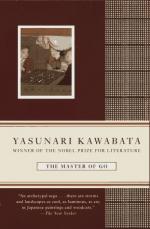|
This section contains 2,034 words (approx. 7 pages at 300 words per page) |

|
SOURCE: "The Floating World," in The Atlantic, Vol. 230, No. 4, October, 1972, pp. 126-29.
In the following essay, Maddocks discusses Kawabata's The Master of Go, Yukio Mishima's Spring Snow, and the tradition of Japanese literature.
There is a fascinatingly mysterious print by Hiroshige called The Cave at Enoshima. At the left, three figures are shown entering the island's grotto, a famous shrine. Dwarfs frozen in awe, they are blind to the enormous white-capped wave that seems to be reaching in after them like a dragon's tongue. A gnarled tree worthy of Samuel Beckett stands watch above the mouth of the cave like a crippled sentry. But the background is a bland denial of the foreground motif. A flat blue sea stretches off vaguely into the distance, and three motionless white sails add a touch of postcard lyricism. It is as if two different artists were at work here: a complacent...
|
This section contains 2,034 words (approx. 7 pages at 300 words per page) |

|


